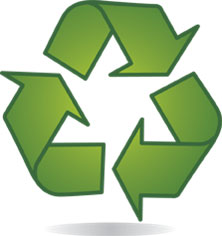Hot-Dip Galvanizing: Reuse, Reclaim, Recycle
When it comes to the end of life for a hot-dip galvanized steel project, there are three options available – none of which include the landfill. Hot-dip galvanized steel can be reused, reprocessed, or reclaimed and recycled. Let’s discuss each in more detail.
Reuse of Galvanized Steel

An often-overlooked sustainable aspect of hot-dip galvanized steel is the ability to reuse it. Hot-dip galvanizing provides maintenance-free corrosion protection for 70+ years in atmospheric environments. Often that is longer than the design life of the project. In that instance, it is possible to take the galvanized steel from one demolition site and repurpose it for use in a new site. There are a number of companies who specialize in reclaiming items from demolition sites to resell to new construction.
On the other hand, some projects reuse galvanized steel for the same purpose over and over by taking it down, stripping the remaining zinc off and re-dipping the steel to reinstall in the project. This also saves environmental impact and costs. It is a common practice with guardrail in many states.

Infinitely Renewable Resources
In addition to being natural and abundant, both zinc and steel are infinitely recyclable without the loss of any physical or chemical properties. This means rather than being down-cycled into other, lesser product, zinc and steel can be used as zinc and steel again and again without compromising their integrity. Therefore, hot-dip galvanized steel is a cradle-to-cradle product, as there is essentially no grave for the zinc or steel.
The 100% recyclability of hot-dip galvanized steel is a great benefit to minimizing environmental impact, but it is only half of the story. The ability for both zinc and steel to be recycled is important, but to capitalize on the positive contribution, they must actually be reclaimed for reuse. Therefore it is important to consider both the recycled content, amount of a product produced from recycled sources, and reclamation rate, how often a product is actually recycled at the end of its useful life. Steel is the most recycled material in the world, and zinc has a very high reclamation rate and often the reclaimed zinc and steel are put right back into use.
| Zinc | Steel | |
|---|---|---|
| Recycling Rate | 30% | 70% |
| Reclamation Rate | 80% | 100% |
Riviere Cochon Gras Bridge: Perches, Haiti; 2019

There’s an old saying, “one person’s trash is another person’s treasure.” In the case of the Riviere Cochon Gras Bridge, that saying became reality. An 80-foot section of the temporary Fore River Bridge which carried people over the river between North Weymouth and Quincy Point, Massachusetts for 15 years, was reused to help the community of Perches, Haiti.
Perches is a remote community in Haiti near the Riviere Cochon Gras. The river crossing was prone to regular flooding and there was no bridge in place. When the river flooded, residents were restricted from medical care and local services, and there had even been a few cases of drownings over the year as people attempted to cross the river to get into town.
Hot-dip galvanizing was the only coating able to stand the test of time serving 15 years as the Fore River Bridge in Massachusetts only to be disassembled, shipped halfway around the world, and then reused in Haiti with no signs of corrosion or repair required. Hot-dip galvanized steel’s durability and maintenance-free longevity make the possibilities for other projects like this endless. Plain and simple, this project is a win-win.